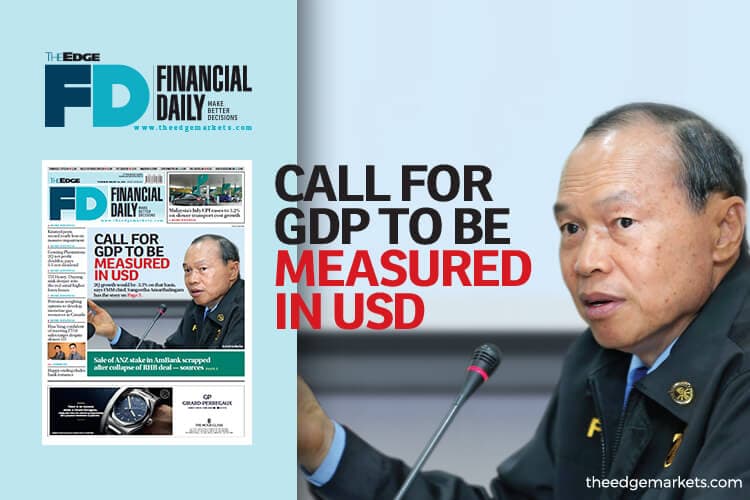
This article first appeared in The Edge Financial Daily on August 24, 2017
KUALA LUMPUR: As a nation heavily involved in international trade, Malaysia’s gross domestic product (GDP) should also be measured in terms of the US dollar for a better reflection of its economic growth, a manufacturing industry leader has argued.
Federation of Malaysian Manufacturers (FMM) president Tan Sri Dr Lim Wee Chai said the country’s current GDP would have contracted if calculated on that basis due to the fall in the ringgit’s value.
“The GDP grew 5.8% in the second quarter of 2017 (2Q17) ... but it grew in ringgit. If we calculated in [the] US dollar, it would be about -3.3% because the ringgit has devalued by 9%,” said Lim.
“The GDP shows proper indication in ringgit. However, there is no growth in dollars. In terms of dollars, it did not grow. It is a minus growth,” he said at a media conference yesterday to announce the results of its 11th joint survey with the Malaysian Institute of Economic Research (MIER).
According to Lim, the nation’s per capita growth in terms of the US dollar is not growing.
“We do business in the world market, so we must bench up. [In order] to become a developed country, [the] GDP should be based on the dollar, not ringgit. As such, our per capita in dollars is not growing,” he said.
The ringgit has slipped 9% since April 1, 2016 when it strengthened to 3.8905 against the US dollar. It closed at 4.279 to the greenback yesterday.
Lim noted that the GDP growth in first half of 2017 (1H17) was supported by the export segment of the manufacturing sector and domestic demand.
Last Friday, Bank Negara Malaysia (BNM) announced that Malaysia’s economy expanded by 5.8% in 2Q17 and 5.7% in 1H17, with growth supported by domestic demand, particularly private sector spending.
From the supply side, improvement was driven by a broad-based expansion across all major sectors, the central bank said.
Going forward, BNM said the GDP is expected to grow at above 4.8% in 2017, given the strong growth in 1H17.
“Domestic demand is projected to underpin this expansion. On the external front, exports are expected to benefit from the stronger-than-expected improvement in global growth,” the central bank said.
The FMM-MIER joint survey, conducted on 396 respondents, focused on local business conditions for 1H17 and the outlook for 2H17.
FMM past president Tan Sri Saw Choon Boon said the survey results show that some respondents’ business did not grow as fast as others in 1H17 or as indicated by the GDP.
“The 1H17 was not a bad period and the GDP shows very good growth but that does not mean everybody experienced the same [because] it is not filtered across the entire economy.
“So manufacturing as a whole actually did do well mainly because of exports but not all manufacturers’ exports. Looking at the BNM figures, domestic consumption for 1H17 was good although there are many sectors in domestic demand.
“For instance, the retail outlook was not so positive. Our members who manufactured for the retail outlet did not do so well as those who manufactured for others parts of the economy,” Saw said.
Overall, the headline figure improved but when delved deeper, Saw said, it would show that some businesses gained ‘more, less or not so much’.
“But I think the message is — relative to last year, the 1H17 figure is good and for 2H17, manufacturers are more positive than the 1H17,” he said.
Saw noted that the manufacturing segment recorded an overall growth of 6% in 1H17, 8.3% growth for construction and 6.3% for services.
Meanwhile, 38% of the survey respondents expect export sales to pick up in 2H17, up from 31% in 1H17, as a result of a favourable foreign exchange rate while 21% project lower sales abroad and 41% remained neutral.
“The statistics show good export in 2H17 because of a weaker ringgit which means we become more cost-efficient, and labour and operation costs become cheaper. However, that is not so good.
“We must be competitive, efficient and productive. We have [a] quality product to compete to gain market share but ringgit devaluation is not our effort, so it is not a good way to gain market share,” he said.
Lim said that the outlook is like any other business, where the latter must be managed efficiently with good quality goods.
“If the government does not manage [the economy] well, the outlook is not good. The stability and security of the government are important.
The number of government servants is relatively high which is a cost to the government.
“If it is a cost to the government, it means a cost to the industries, and that would increase the cost of doing business. If a business is not efficient, that will show in the bottom line. So if we work well with the government, the outlook for the export sector would be good,” Lim said.
The survey also showed that 59% of respondents believed that manufacturing costs would go up in 2H17 compared with 72% who said the same in 1H17.
“The cost of manufacturing will continue to rise but on a lower rate than before. Previously, government policies and unregulated services particularly in the logistics sector caused a rise in the costs of doing business,” he said.
Lim added that the most common manufacturing cost profile was raw materials (60%), labour (20%), energy (10%), logistics (5%) and water (1%).